technical data SKODA FABIA 2010 2.G / 5J User Guide
[x] Cancel search | Manufacturer: SKODA, Model Year: 2010, Model line: FABIA, Model: SKODA FABIA 2010 2.G / 5JPages: 244, PDF Size: 29.53 MB
Page 22 of 244
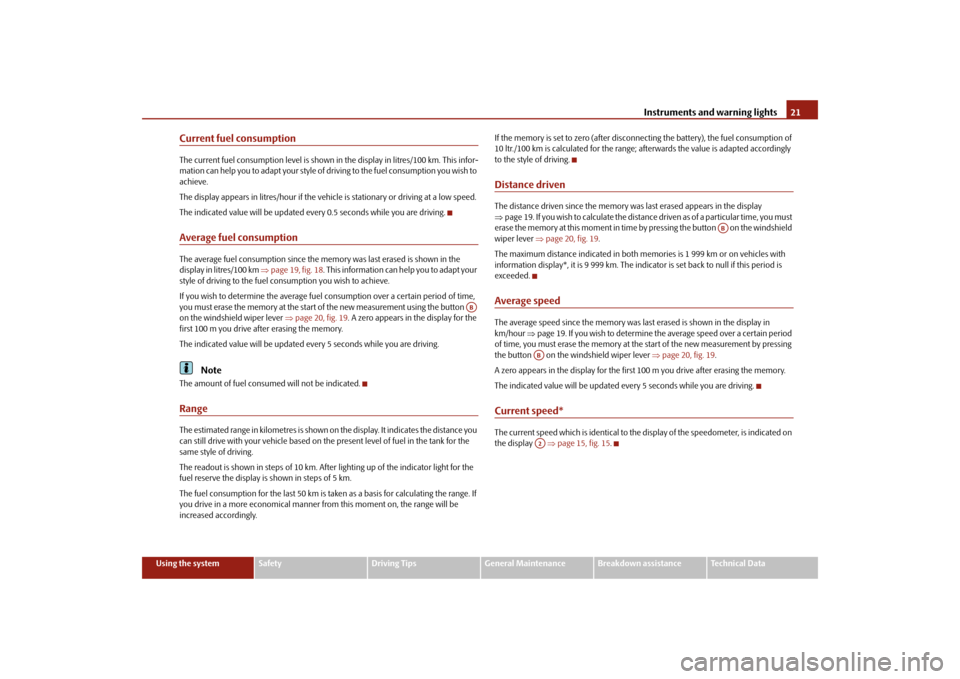
Instruments and warning lights
21
Using the system
Safety
Driving Tips
General Maintenance
Breakdown assistance
Technical Data
Current fuel consumptionThe current fuel consumption level is shown in the display in litres/100 km. This infor- mation can help you to adapt your style of
driving to the fuel consumption you wish to
achieve. The display appears in litres/hour if the vehicle is stationary or driving at a low speed.The indicated value will be updated every 0.5 seconds while you are driving.Average fuel consumptionThe average fuel consumption since the memory was last erased is shown in the display in litres/100 km
page 19, fig. 18
. This information can help you to adapt your
style of driving to the fuel co
nsumption you wish to achieve.
If you wish to determine the average fuel
consumption over a cert
ain period of time,
you must erase the memory at the start of the new measurement using the button on the windshield wiper lever
page 20, fig. 19
. A zero appears in the display for the
first 100 m you drive after erasing the memory. The indicated value will be updated every 5 seconds while you are driving.
Note
The amount of fuel consum
ed will not be indicated.
RangeThe estimated range in kilometres is shown on
the display. It indicates the distance you
can still drive with your vehicle based on th
e present level of fuel in the tank for the
same style of driving. The readout is shown in steps of 10 km. After
lighting up of the indicator light for the
fuel reserve the display is shown in steps of 5 km. The fuel consumption for the last 50 km is ta
ken as a basis for calculating the range. If
you drive in a more economical manner fr
om this moment on, the range will be
increased accordingly.
If the memory is set to zero (after discon
necting the battery), the fuel consumption of
10 ltr./100 km is calculated for the range;
afterwards the value is adapted accordingly
to the style of driving.Distance drivenThe distance driven since the memory was last erased appears in the display page 19. If you wish to calculate the distance
driven as of a particular time, you must
e ras e the m emor y a t thi s mom ent in ti me by pres sing the button on the winds hie ld wiper lever
page 20, fig. 19
.
The maximum distance indicated in both memories is 1 999 km or on vehicles with information display*, it is 9 999 km. The indicator is set back to null if this period is exceeded.Average speedThe average speed since the memory was last erased is shown in the display in km/hour
page 19. If you wish to determine the average speed over a certain period
of time, you must erase the memory at the start of the new measurement by pressing the button on the windshield wiper lever
page 20, fig. 19
.
A zero appears in the display for the first 100 m you drive after erasing the memory.The indicated value will be updated every 5 seconds while you are driving.Current speed*The current speed which is identical to the display of the speedometer, is indicated on the display
page 15, fig. 15
.
AB
AB
ABA2
s3j8.a.book Page 21 Tuesday, April 20, 2010 1:10 PM
Page 24 of 244
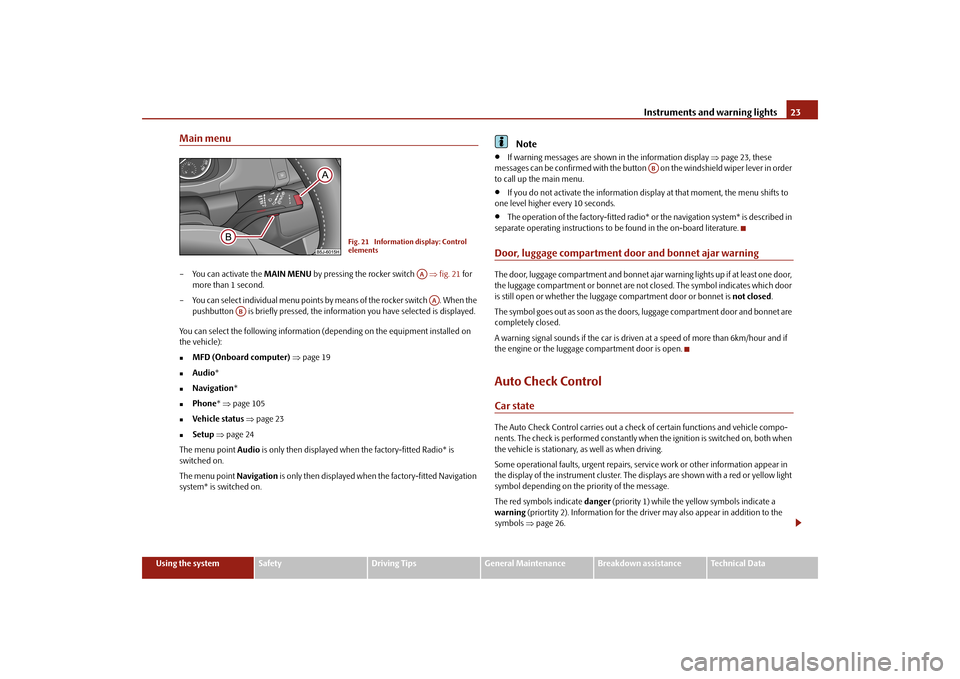
Instruments and warning lights
23
Using the system
Safety
Driving Tips
General Maintenance
Breakdown assistance
Technical Data
Main menu– You can activate the
MAIN MENU
by pressing the rocker switch
fig. 21
for
more than 1 second.
– You can select individual menu points by means of the rocker switch . When the
pushbutton is briefly pressed, the info
rmation you have sele
cted is displayed.
You can select the following information (d
epending on the equipment installed on
the vehicle):
MFD (Onboard computer)
page 19
Audio
*
Navigation
*
Phone
* page 105
Vehicle status
page 23
Setup
page 24
The menu point
Audio
is only then displayed when
the factory-fitted Radio* is
switched on. The menu point
Navigation
is only then displayed when the factory-fitted Navigation
system* is switched on.
Note
If warning messages are shown in the information display
page 23, these
messages can be confirmed with the button on the windshield wiper lever in order to call up the main menu.
If you do not activate the information disp
lay at that moment, the menu shifts to
one level higher every 10 seconds.
The operation of the factory-fitted radio*
or the navigation system* is described in
separate operating instructions to be
found in the on-board literature.
Door, luggage compartment door and bonnet ajar warningThe door, luggage compartment and bonnet ajar
warning lights up if at least one door,
the luggage compartment or bonnet are not closed. The symbol indicates which door is still open or whether the luggage
compartment door or bonnet is
not closed
.
The symbol goes out as soon as the doors,
luggage compartment door and bonnet are
completely closed. A warning signal sounds if the car is driven at a speed of more than 6km/hour and if the engine or the luggage compartment door is open.Auto Check ControlCar stateThe Auto Check Control carries out a chec
k of certain functions and vehicle compo-
nents. The check is performed constantly when
the ignition is switched on, both when
the vehicle is stationary, as well as when driving. Some operational faults, urgent repairs, se
rvice work or other information appear in
the display of the instrument cluster. The di
splays are shown with a red or yellow light
symbol depending on the priority of the message. The red symbols indicate
danger
(priority 1) while the yellow symbols indicate a
warning
(priortity 2). Information for the driver
may also appear in addition to the
symbols
page 26.
Fig. 21 Information display: Control elements
AAAA
AB
AB
s3j8.a.book Page 23 Tuesday, April 20, 2010 1:10 PM
Page 26 of 244
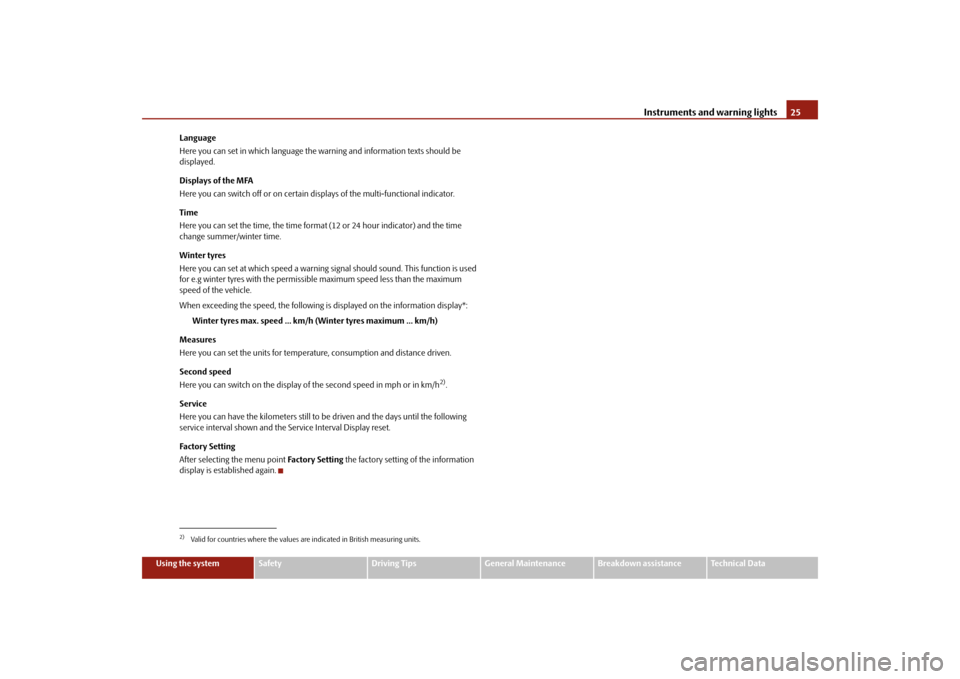
Instruments and warning lights
25
Using the system
Safety
Driving Tips
General Maintenance
Breakdown assistance
Technical Data
Language Here you can set in which language the
warning and information texts should be
displayed. Displays of the MFA Here you can switch off or on certain di
splays of the multi-
functional indicator.
Time Here you can set the time, the time format (12 or 24 hour indicator) and the time change summer/winter time. Winter tyres Here you can set at which speed a warning si
gnal should sound. This function is used
for e.g winter tyres with the permissibl
e maximum speed less than the maximum
speed of the vehicle. When exceeding the speed, the following is
displayed on the information display*:
Winter tyres max. speed ... km/h (Winter tyres maximum ... km/h)
Measures Here you can set the units for temperat
ure, consumption and distance driven.
Second speed Here you can switch on the display of
the second speed in mph or in km/h
2).
Service Here you can have the kilometers still to
be driven and the days until the following
service interval shown and the Service Interval Display reset. Factory Setting After selecting the menu point
Factory Setting
the factory setting of the information
display is established again.2)Valid for countries where the values are indicated in British measuring units.
s3j8.a.book Page 25 Tuesday, April 20, 2010 1:10 PM
Page 28 of 244
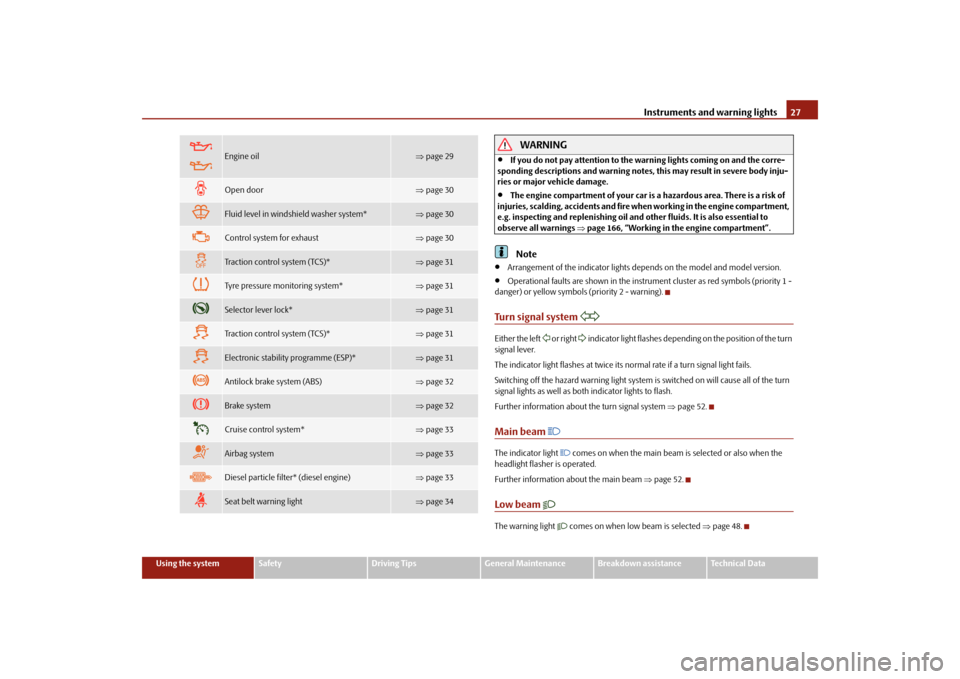
Instruments and warning lights
27
Using the system
Safety
Driving Tips
General Maintenance
Breakdown assistance
Technical Data
WARNING
If you do not pay attention to the warning lights coming on and the corre-
sponding descriptions and warning notes, this may result in severe body inju- ries or major vehicle damage.
The engine compartment of your car is
a hazardous area. There is a risk of
injuries, scalding, accidents and fire wh
en working in the engine compartment,
e.g. inspecting and replenishing oil and
other fluids. It is also essential to
observe all warnings
page 166, “Working in the engine compartment”.
Note
Arrangement of the indicator lights depends on the model and model version.
Operational faults are shown in the instrument cluster as red symbols (priority 1 -
danger) or yellow symbol
s (priority 2 - warning).
Turn signal system
Either the left
or right
indicator light flashes depending on the position of the turn
signal lever. The indicator light flashes at twice its normal rate if a turn signal light fails.Switching off the hazard warning light system is switched on will cause all of the turn signal lights as well as both indicator lights to flash. Further information about the turn signal system
page 52.
Main beam
The indicator light
comes on when the main beam is selected or also when the
headlight flasher is operated. Further information about the main beam
page 52.
Low beam
The warning light
comes on when low beam is selected
page 48.
Engine oil
page 29
Open door
page 30
Fluid level in windshield washer system*
page 30
Control system for exhaust
page 30
Traction control system (TCS)*
page 31
Tyre pressure monitoring system*
page 31
Selector lever lock*
page 31
Traction control system (TCS)*
page 31
Electronic stability programme (ESP)*
page 31
Antilock brake system (ABS)
page 32
Brake system
page 32
Cruise control system*
page 33
Airbag system
page 33
Diesel particle filter* (diesel engine)
page 33
Seat belt warning light
page 34
s3j8.a.book Page 27 Tuesday, April 20, 2010 1:10 PM
Page 30 of 244
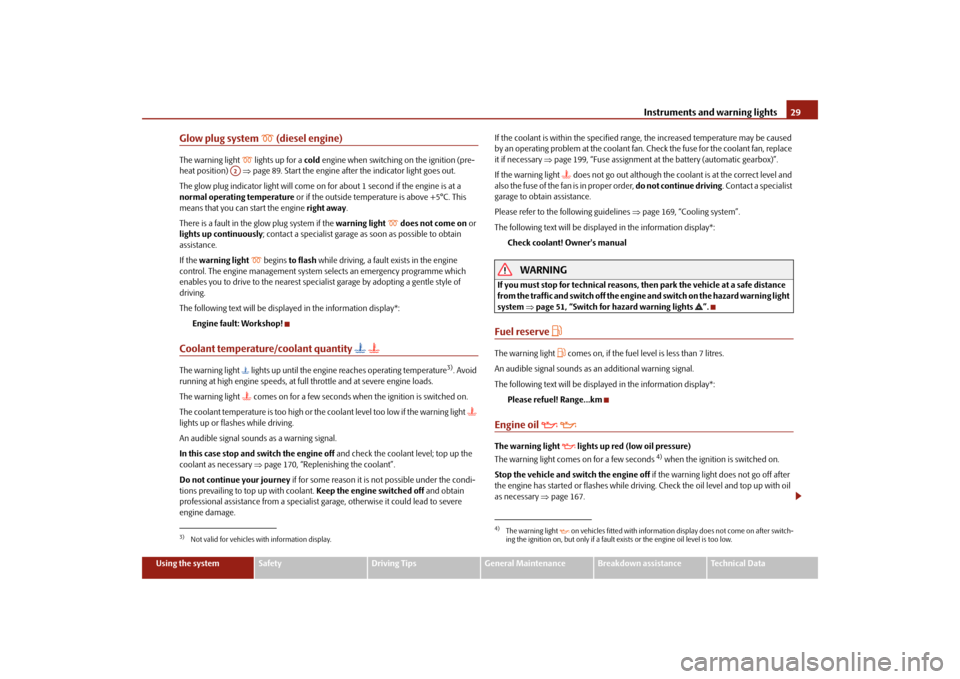
Instruments and warning lights
29
Using the system
Safety
Driving Tips
General Maintenance
Breakdown assistance
Technical Data
Glow plug system
(diesel engine)
The warning light
lights up for a
cold
engine when switching on the ignition (pre-
heat position)
page 89. Start the engine after the indicator light goes out.
The glow plug indicato
r light will come on for about 1
second if the engine is at a
normal operating temperature
or if the outside temperature is above +5°C. This
means that you can start the engine
right away
.
There is a fault in the glow plug system if the
warning light
does not come on
or
lights up continuously
; contact a specialist garage as soon as possible to obtain
assistance. If the
warning light
begins
to flash
while driving, a fault exists in the engine
control. The engine management system
selects an emergency programme which
enables you to drive to the nearest specialist garage by adopting a gentle style of driving. The following text will be displayed in the information display*:
Engine fault: Workshop!
Coolant temperature/coolant quantity
The warning light
lights up until the engine reaches operating temperature
3). Avoid
running at high engine speeds, at full
throttle and at se
vere engine loads.
The warning light
comes on for a few seconds when
the ignition is switched on.
The coolant temperature is too high or the
coolant level too low if the warning light
lights up or flashes while driving. An audible signal sounds as a warning signal.In this case stop and switch the engine off
and check the coolant level; top up the
coolant as necessary
page 170, “Replenishing the coolant”.
Do not continue your journey
if for some reason it is not possible under the condi-
tions prevailing to top up with coolant.
Keep the engine switched off
and obtain
professional assistance from a specialist garage, otherwise it could lead to severe engine damage.
If the coolant is within the specified range, the increased temperature may be caused by an operating problem at the coolant fan.
Check the fuse for the coolant fan, replace
it if necessary
page 199, “Fuse assignment at th
e battery (automatic gearbox)”.
If the warning light
does not go out although the coolant is at the correct level and
also the fuse of the fan is in proper order,
do not continue driving
. Contact a specialist
garage to obtain assistance. Please refer to the following guidelines
page 169, “Cooling system”.
The following text will be displayed in the information display*:
Check coolant! Owner's manual
WARNING
If you must stop for technical reasons, then park the vehicle at a safe distance from the traffic and switch off the engine and switch on the hazard warning light system
page 51, “Switch for hazard warning lights
”.
Fuel reserve
The warning light
comes on, if the fuel level is less than 7 litres.
An audible signal sounds as an additional warning signal.The following text will be displayed in the information display*:
Please refuel! Range...km
Engine oil
The warning light
lights up red (low oil pressure)
The warning light comes on for a few seconds
4) when the ignition is switched on.
Stop the vehicle and switch the engine off
if the warning light does not go off after
the engine has started or flashes while driving. Check the oil level and top up with oil as necessary
page 167.
3)Not valid for vehicles with information display.
A2
4)The warning light
on vehicles fitted with information
display does not come on after switch-
ing the ignition on, but only if a fault exists or the engine oil level is too low.
s3j8.a.book Page 29 Tuesday, April 20, 2010 1:10 PM
Page 32 of 244
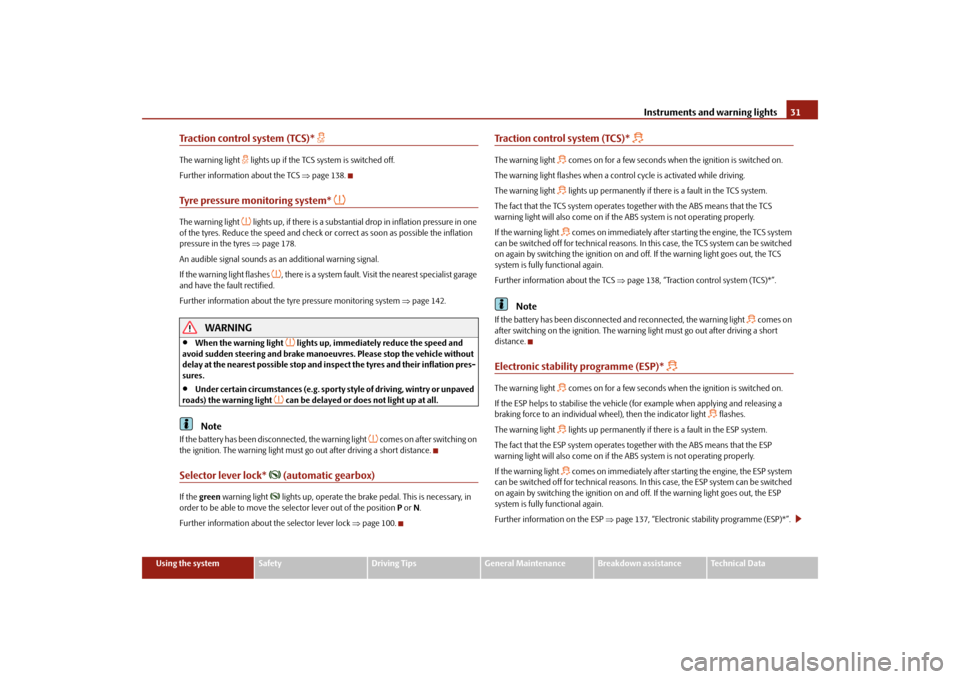
Instruments and warning lights
31
Using the system
Safety
Driving Tips
General Maintenance
Breakdown assistance
Technical Data
Traction control system (TCS)*
The warning light
lights up if the TCS
system is switched off.
Further information about the TCS
page 138.
Tyre pressure monitoring system*
The warning light
lights up, if there is a substantia
l drop in inflation pressure in one
of the tyres. Reduce the speed and check or
correct as soon as possible the inflation
pressure in the tyres
page 178.
An audible signal sounds as an additional warning signal.If the warning light flashes
, there is a system fault. Visit the nearest specialist garage
and have the fault rectified. Further information about the tyre pressure monitoring system
page 142.
WARNING
When the warning light
lights up, immediately reduce the speed and
avoid sudden steering and brake manoeuvr
es. Please stop the vehicle without
delay at the nearest possible stop and in
spect the tyres and their inflation pres-
sures.
Under certain circumstances (e.g. sporty style of driving, wintry or unpaved
roads) the warning light
can be delayed or does not light up at all.
Note
If the battery has been disconnected, the warning light
comes on after switching on
the ignition. The warning light must go out after driving a short distance.Selector lever lock*
(automatic gearbox)
If the
green
warning light
lights up, operate the brake pedal. This is necessary, in
order to be able to move the selector lever out of the position
P or N.
Further information about the selector lever lock
page 100.
Traction control system (TCS)*
The warning light
comes on for a few seconds when the ignition is switched on.
The warning light flashes when a control cycle is activated while driving.The warning light
lights up permanently if there is a fault in the TCS system.
The fact that the TCS system operates together with the ABS means that the TCS warning light will also come on if the ABS system is not operating properly. If the warning light
comes on immediately after starting the engine, the TCS system
can be switched off for techni
cal reasons. In this case, the TCS system can be switched
on again by switching the igni
tion on and off. If the warning light goes out, the TCS
system is fully functional again. Further information about the TCS
page 138, “Traction control system (TCS)*”.
Note
If the battery has been disconnected
and reconnected, the warning light
comes on
after switching on the ignition. The warning light must go out after driving a short distance.Electronic stability programme (ESP)*
The warning light
comes on for a few seconds when the ignition is switched on.
If the ESP helps to stabilise the vehicle (f
or example when applying and releasing a
braking force to an individual wheel), then the indicator light
flashes.
The warning light
lights up permanently if there is a fault in the ESP system.
The fact that the ESP system operates together with the ABS means that the ESP warning light will also come on if the ABS system is not operating properly. If the warning light
comes on immediately after starting the engine, the ESP system
can be switched off for technical reasons. In
this case, the ESP system can be switched
on again by switching the igni
tion on and off. If the warning light goes out, the ESP
system is fully functional again. Further information on the ESP
page 137, “Electronic stab
ility programme (ESP)*”.
s3j8.a.book Page 31 Tuesday, April 20, 2010 1:10 PM
Page 34 of 244
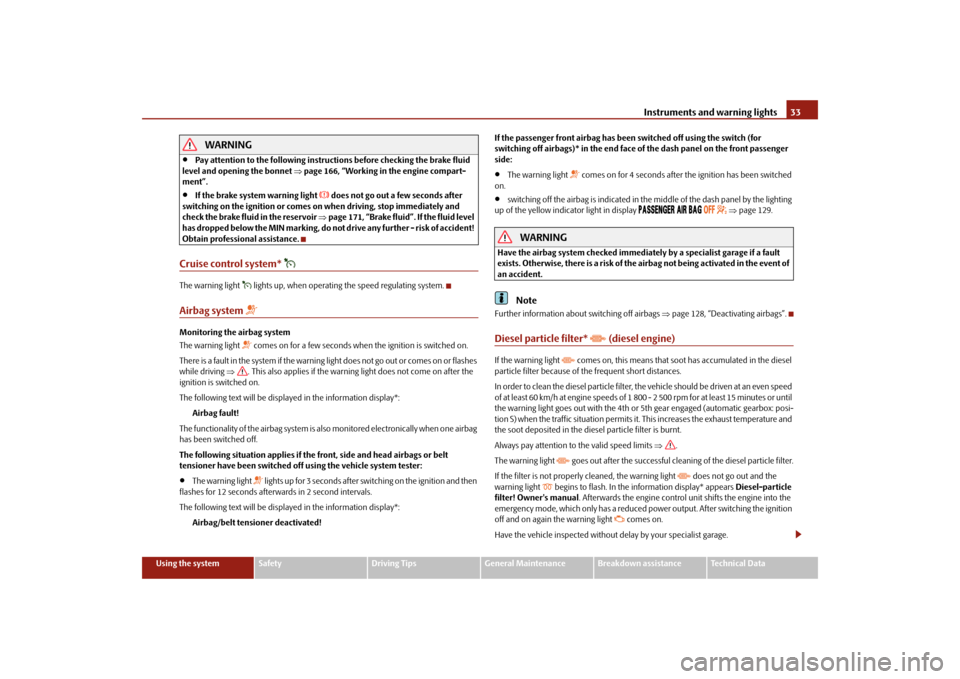
Instruments and warning lights
33
Using the system
Safety
Driving Tips
General Maintenance
Breakdown assistance
Technical Data
WARNING
Pay attention to the following instruct
ions before checking the brake fluid
level and opening the bonnet
page 166, “Working in the engine compart-
ment”.
If the brake system warning light
does not go out a few seconds after
switching on the ignition or comes on when driving, stop immediately and check the brake fluid in the reservoir
page 171, “Brake fluid”. If the fluid level
has dropped below the MIN marking, do no
t drive any further - risk of accident!
Obtain professional assistance.Cruise control system*
The warning light
lights up, when operating the speed regulating system.
Airbag system
Monitoring the airbag system The warning light
comes on for a few seconds when the ignition is switched on.
There is a fault in the system if the warning
light does not go out or comes on or flashes
while driving
. This also applies if the warning
light does not come on after the
ignition is switched on. The following text will be displayed in the information display*:
Airbag fault!
The functionality of the airbag system is also monitored electronically when one airbag has been switched off. The following situation applies if the fr
ont, side and head airbags or belt
tensioner have been switched off
using the vehicle system tester:
The warning light
lights up for 3 seconds after switching on the ignition and then
flashes for 12 seconds afterwards in 2 second intervals. The following text will be displayed in the information display*:
Airbag/belt tensioner deactivated!
If the passenger front airbag has been
switched off using the switch (for
switching off airbags)* in the end face of
the dash panel on the front passenger
side:
The warning light
comes on for 4 seconds after the ignition has been switched
on.
switching off the airbag is indicated in the middle of the dash panel by the lighting
up of the yellow indicator light in display
page 129.
WARNING
Have the airbag system checked immediat
ely by a specialist
garage if a fault
exists. Otherwise, there is a
risk of the airbag not bein
g activated in the event of
an accident.
Note
Further information about switching off airbags
page 128, “Deactivating airbags”.
Diesel particle filter*
(diesel engine)
If the warning light
comes on, this means that soot
has accumulated in the diesel
particle filter because of the frequent short distances. In order to clean the diesel particle filter, the vehicle should be driven at an even speed of at least 60 km/h at engine speeds of 1
800 - 2 500 rpm for at least 15 minutes or until
the warning light goes out with the 4th or
5th gear engaged (automatic gearbox: posi-
tion S) when the traffic situation permits it. This increases the exhaust temperature and the soot deposited in the diesel particle filter is burnt. Always pay attention to the valid speed limits
.
The warning light
goes out after the successful cleaning of the diesel particle filter.
If the filter is not properly
cleaned, the warning light
does not go out and the
warning light
begins to flash. In the in
formation display* appears
Diesel-particle
filter! Owner's manual
. Afterwards the engine control unit shifts the engine into the
emergency mode, which only has a reduced po
wer output. After switching the ignition
off and on again the warning light
comes on.
Have the vehicle inspected without
delay by your specialist garage.
s3j8.a.book Page 33 Tuesday, April 20, 2010 1:10 PM
Page 36 of 244
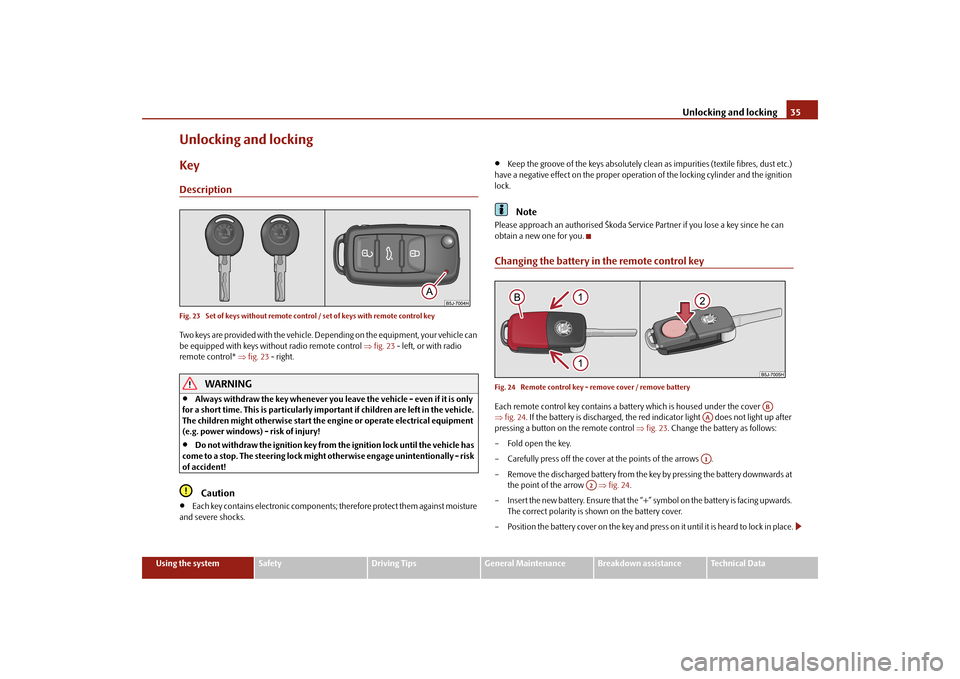
Unlocking and locking
35
Using the system
Safety
Driving Tips
General Maintenance
Breakdown assistance
Technical Data
Unlocking and lockingKeyDescriptionFig. 23 Set of keys without remote control / set of keys with remote control keyTwo keys are provided with the vehicle. Depending on the equipment, your vehicle can be equipped with keys without radio remote control
fig. 23
- left, or with radio
remote control*
fig. 23
- right.
WARNING
Always withdraw the key whenever you le
ave the vehicle - even if it is only
for a short time. This is particularly important if children are left in the vehicle. The children might otherwise start the en
gine or operate electrical equipment
(e.g. power windows) - risk of injury!
Do not withdraw the ignition key from the ignition lock until the vehicle has
come to a stop. The steerin
g lock might otherwise enga
ge unintentionally - risk
of accident!
Caution
Each key contains electronic components; therefore protect them against moisture
and severe shocks.
Keep the groove of the keys absolutely clean as impurities (textile fibres, dust etc.)
have a negative effect on the proper operation of the locking cylinder and the ignition lock.
Note
Please approach an authorised Škoda Servic
e Partner if you lose a key since he can
obtain a new one for you.Changing the battery in the remote control keyFig. 24 Remote control key - remove cover / remove batteryEach remote control key contains a batt
ery which is housed under the cover
fig. 24
. If the battery is discharged, the red in
dicator light does not light up after
pressing a button on the remote control
fig. 23
. Change the battery as follows:
– Fold open the key.– Carefully press off the cover at the points of the arrows .– Remove the discharged battery from the key by pressing the battery downwards at
the point of the arrow
fig. 24
.
– Insert the new battery. Ensure that the “+”
symbol on the battery is facing upwards.
The correct polarity is shown on the battery cover.
– Position the battery cover on the key and press on it until it is heard to lock in place.
AB
AA A1
A2
s3j8.a.book Page 35 Tuesday, April 20, 2010 1:10 PM
Page 38 of 244
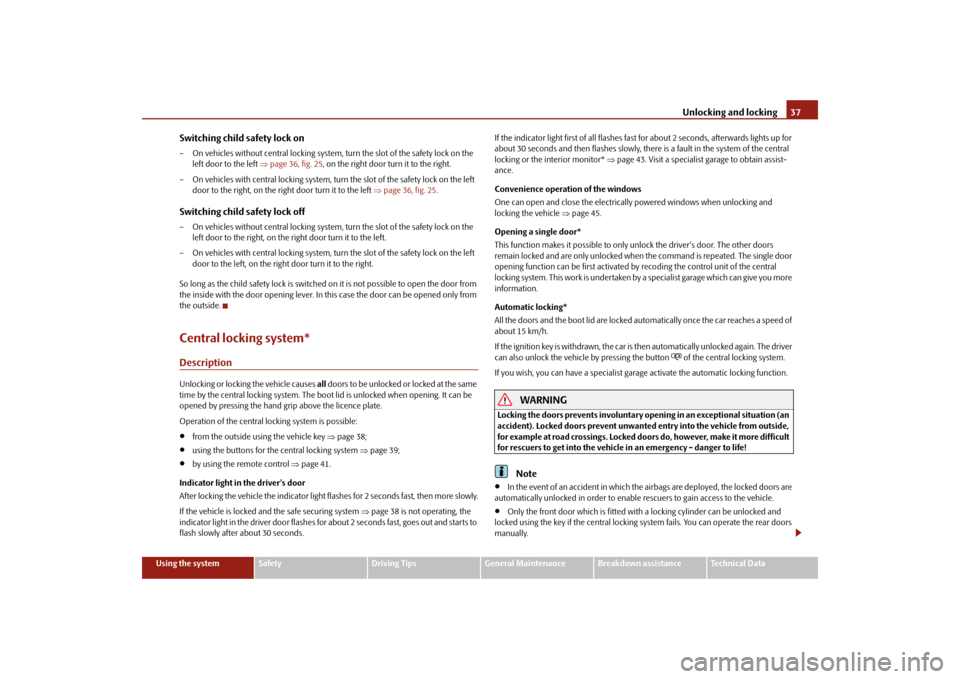
Unlocking and locking
37
Using the system
Safety
Driving Tips
General Maintenance
Breakdown assistance
Technical Data
Switching child safety lock on– On vehicles without central locking system,
turn the slot of the safety lock on the
left door to the left
page 36, fig. 25
, on the right door turn it to the right.
– On vehicles with central locking system, turn
the slot of the safety lock on the left
door to the right, on the right door turn it to the left
page 36, fig. 25
.
Switching child safety lock off– On vehicles without central locking system,
turn the slot of the safety lock on the
left door to the right, on the right door turn it to the left.
– On vehicles with central locking system, turn
the slot of the safety lock on the left
door to the left, on the right door turn it to the right.
So long as the child safety lock is switched
on it is not possible to open the door from
the inside with the door opening lever. In th
is case the door can be opened only from
the outside.Central locking system*DescriptionUnlocking or locking the vehicle causes
all doors to be unlocked or locked at the same
time by the central locking system. The boot lid is unlocked when opening. It can be opened by pressing the hand grip above the licence plate. Operation of the central locking system is possible:
from the outside using the vehicle key
page 38;
using the buttons for the
central locking system
page 39;
by using the remote control
page 41.
Indicator light in the driver's door After locking the vehicle the indicator light fl
ashes for 2 seconds fast, then more slowly.
If the vehicle is locked and the safe securing system
page 38 is not operating, the
indicator light in the driver door flashes for
about 2 seconds fast, goes out and starts to
flash slowly after about 30 seconds.
If the indicator light first of all flashes fast for about 2 seconds, afterwards lights up for about 30 seconds and then flashes slowly, there is a fault in the system of the central locking or the interior monitor*
page 43. Visit a specialist garage to obtain assist-
ance. Convenience operation of the windows One can open and close the electrically
powered windows when unlocking and
locking the vehicle
page 45.
Opening a single door* This function makes it possible to only unlock the driver's door. The other doors remain locked and are only unlocked when
the command is repeated. The single door
opening function can be first activated by recoding the control unit of the central locking system. This work is undertaken by a specialist garage which can give you more information. Automatic locking* All the doors and the boot lid are locked au
tomatically once the car reaches a speed of
about 15 km/h. If the ignition key is withdrawn, the car is
then automatically unlocked again. The driver
can also unlock the vehicle
by pressing the button
of the central locking system.
If you wish, you can have a specialist gara
ge activate the automatic locking function.
WARNING
Locking the doors prevents involuntary op
ening in an exceptional situation (an
accident). Locked doors prevent unwanted entry into the vehicle from outside, for example at road crossings. Locked do
ors do, however, make it more difficult
for rescuers to get into the vehicle
in an emergency - danger to life!
Note
In the event of an accident in which the airbags are deployed, the locked doors are
automatically unlocked in order to enable
rescuers to gain access to the vehicle.
Only the front door which is fitted with
a locking cylinder can be unlocked and
locked using the key if the central locking sy
stem fails. You can operate the rear doors
manually.
s3j8.a.book Page 37 Tuesday, April 20, 2010 1:10 PM
Page 40 of 244
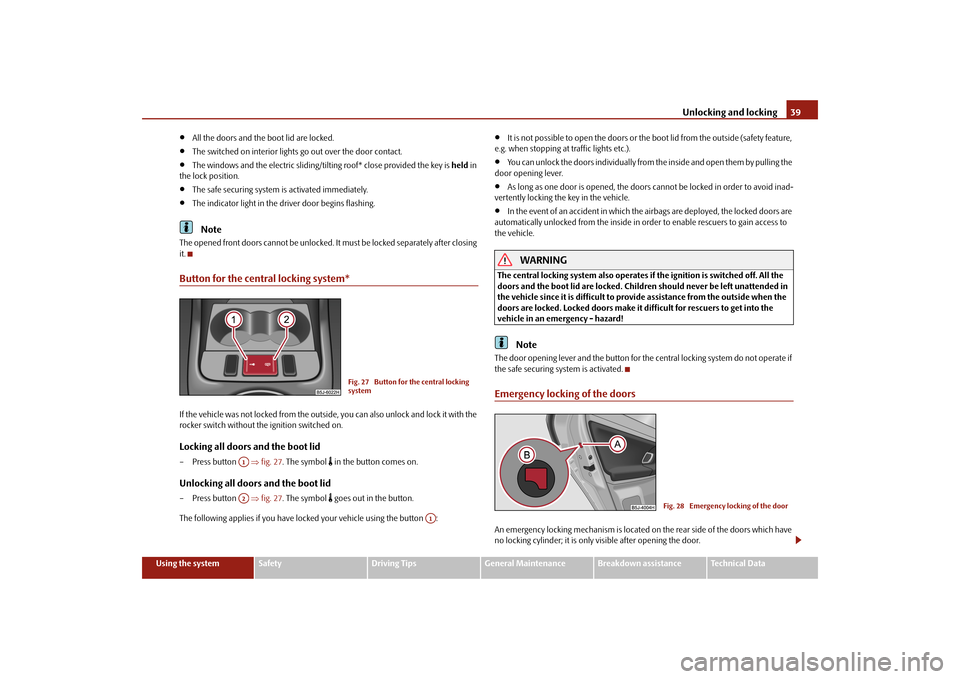
Unlocking and locking
39
Using the system
Safety
Driving Tips
General Maintenance
Breakdown assistance
Technical Data
All the doors and the boot lid are locked.
The switched on interior lights go out over the door contact.
The windows and the electric sliding/tilting roof* close provided the key is
held
in
the lock position.
The safe securing system is activated immediately.
The indicator light in the driver door begins flashing.Note
The opened front doors cannot be unlocked. It
must be locked separately after closing
it.Button for the central locking system*If the vehicle was not locked from the outsid
e, you can also unlock and lock it with the
rocker switch without th
e ignition switched on.
Locking all doors and the boot lid– Press button
fig. 27
. The symbol
in the button comes on.
Unlocking all doors and the boot lid– Press button
fig. 27
. The symbol
goes out in the button.
The following applies if
you have locked your vehicle using the button :
It is not possible to open the doors or the boot lid from the outside (safety feature,
e.g. when stopping at
traffic lights etc.).
You can unlock the doors individually from
the inside and open them by pulling the
door opening lever.
As long as one door is opened, the doors cannot be locked in order to avoid inad-
vertently locking the key in the vehicle.
In the event of an accident in which the airbags are deployed, the locked doors are
automatically unlocked from the inside in orde
r to enable rescuers to gain access to
the vehicle.
WARNING
The central locking system al
so operates if the ignition is switched off. All the
doors and the boot lid are locked. Children should never be left unattended in the vehicle since it is difficult to prov
ide assistance from the outside when the
doors are locked. Locked doors make it difficult for rescuers to get into the vehicle in an emergency - hazard!
Note
The door opening lever and the button for the central locking system do not operate if the safe securing system is activated.Emergency locking of the doorsAn emergency locking mechanism is located on
the rear side of the doors which have
no locking cylinder; it is only
visible after opening the door.
Fig. 27 Button for the central locking system
A1A2
A1
Fig. 28 Emergency locking of the door
s3j8.a.book Page 39 Tuesday, April 20, 2010 1:10 PM